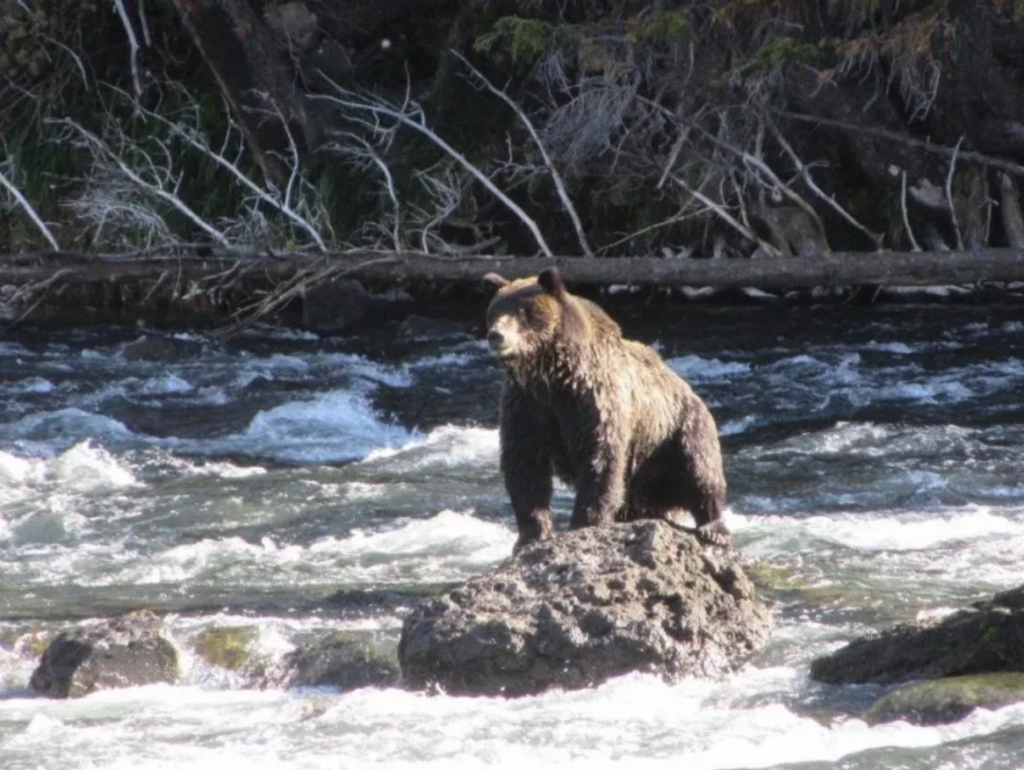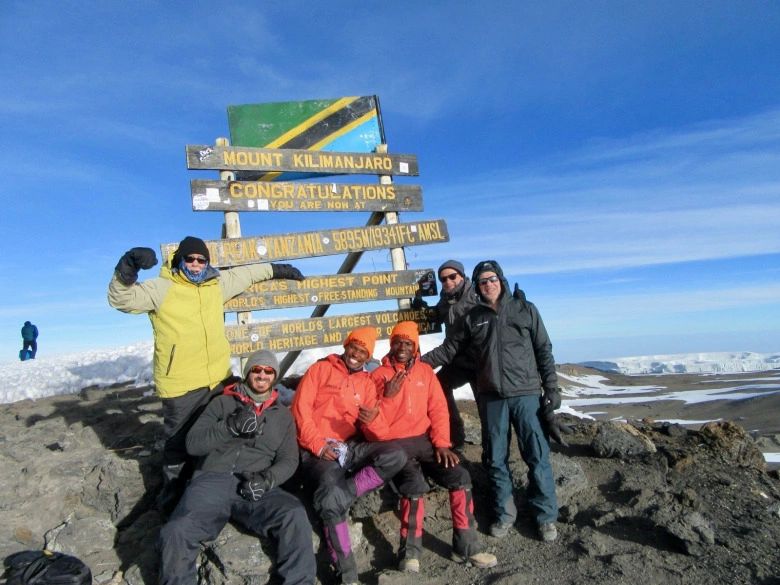IN THIS EARTH DAY TRIBUTE, CONSERVATIONIST AND AMERICAN SAFARI GUIDE PHIL KNIGHT PUTS GREATER YELLOWSTONE IN GLOBAL PERSPECTIVE
By Phil Knight via Mountain Journal

A grizzly searches for trout in the Yellowstone River. Photo by Phil Knight
In early March I returned from Tanzania, Africa, where I visited Serengeti National Park, Ngorongoro Crater and another wildlife park. We watched the great migration of tens of thousands of wildebeest and zebra, and saw many other iconic animals such as elephants, giraffes and lions.
As I traveled home I realized, once again, that I live near a place with a similar abundance and diversity of wildlife as the Serengeti. Greater Yellowstone is on par with global wildlife tourism magnets like the Galapagos, Antarctica, Madagascar and Costa Rica. Wildlife tourism, a major industry here, brings millions of visitors who spend hundreds of millions of dollars every year, just for the chance to spot a wolf or bear or moose.
Here in the Greater Yellowstone Ecosystem we are extremely fortunate to still have all of our native mammals, from shrews to moose, skunks to grizzly bears, dippers to goshawks, weasels to wolves.
This was not always true – wolves were missing for 70 years, and big animals like bison and elk were nearly wiped out by market hunting and extermination campaigns. Even grizzly bears were on the edge of extinction here.
All this diversity and abundance of wildlife is no accident. It is the result of difficult and hard-won conservation efforts focused on preserving habitat, restoring populations, and limiting hunting.
Given a chance, animals are resilient. They evolved here and are adapted to the terrain and the ecology of Greater Yellowstone. Elk and pronghorn and mule deer still make long migrations with hundreds and even thousands of animals. Huge numbers of birds, from eagles to osprey to songbirds, migrate through and many breed here.
Wildlife is gold. Wild animals are valuable in so many ways—ways more valuable than money. They provide inspiration, knowledge, entertainment, yes, tourist dollars, and a look into another world—the world we evolved from and are still a part of. Wildlife bring the landscape to life. Without animals the land is just land, not an ecosystem. Wild animals should be treated like gold, preserved and valued for their immense worth. We could easily lose this goose that lays golden eggs year after year.
Wolverines and lynx are right on the brink of extinction and may soon disappear from Greater Yellowstone. Bison are exterminated by the hundreds every spring. Elk and deer are becoming infected with chronic wasting disease, which is incurable and fatal. Bighorn sheep catch fatal pneumonia from domestic sheep. Wolves cope with diseases brought by domestic dogs. Living wild is not getting any easier.
Hunting is another part of the equation. Many animals face heavy hunting pressure in spring and fall. The hunting of predators such as bears and wolves is highly controversial and its impact on ecosystem health debatable. Although grizzly bears cannot be legally hunted in the lower 48, hunter conflicts are one of the main ways that grizzly bears die.
Sure, Yellowstone and Grand Teton are protected and generally do not allow hunting (though there is an elk hunt every year in Grand Teton). But the habitat does not end at the park borders, nor are these parks big enough to sustain populations of large mammals. Our iconic wildlife need much more room – national forests, wildlife refuges, state land, private land, conservation areas, all of which contribute to sustaining our incredible diversity of wildlife.
Greater Yellowstone is, according to one map 22.5 million acres, and is widely considered to be the most intact ecosystem in the Earth’s temperate zones. That puts a lot of responsibility, and pressure, on us to do the right thing here. Because if we can’t sustain wildlife here, if Greater Yellowstone is not big enough or wild enough, where can we do it?

Only months ago, the author (in yellow jacket) and friends stood on the top of Mt. Kilimanjaro in Tanzania, at 19,341 feet the tallest summit in Africa. Like the still wildlife-rich Serengeti Plain, Knight says the diversity of wildlife in Greater Yellowstone, his home region, is a miracle that needs safeguarding. Photo courtesy Phil Knight
Human population pressure is putting the squeeze on wildlife in Greater Yellowstone. Exploding recreational use and infrastructure, sprawling subdivisions, urban growth, oil and gas development, logging and associated roads, expanding roads and highways, ever-increasing visitation, fences, invasive species, climate chaos, and disease all take a bite out wildlife habitat, populations and wildlife security. Some species have already been pushed out of the lower, richer valleys and into the rougher, more marginal habitat of the mountains. Others must adapt to life near humans, finding ways to take advantage or practice avoidance. Many animals are shifting to living at night, where they can move more secretively.
Yellowstone and Grand Teton are not fenced, so wildlife move relatively freely in and out. Many African game parks are fenced, with the animals only surviving because human access is limited, people stay mostly in their cars and the wildlife are protected by armed guards. They may look wild but they are basically trapped in a big zoo.
Will Yellowstone end up like that? What to do?
Three words: Habitat, habitat, habitat. Leave the land alone, set aside as much wild, undeveloped public land as possible. Then set aside some more. If we want to still have grizzly bears, wolves, free-ranging elk herds, and migrating mule deer, we need lots of wild country. The best way to preserve habitat for these big free-ranging animals is to designate it as Wilderness, thus ensuring development is limited to trails.
We also need more tolerance for these creatures, everywhere they roam. Bison are often treated as vermin and a threat to livestock outside of national parks, even though they are the natives and cows the exotics. Bears are often trapped and relocated or worse, euthanized for transgressing on human habitat. Coyotes are mercilessly trapped and shot and poisoned, wolves trapped and shot, cougars killed for coming close to town. State wildlife agencies focus their efforts on finding more ways for more people to shoot more animals, rather than working to increase respect for and enjoyment of wildlife.
Humans and their livestock and pets are by far the dominant animals on the planet. The remaining wildlife is more valuable and more imperiled by the minute. Something so rare and precious – think 1400 grizzly bears or 4000 bison, compared to millions of humans or cows – should be treated as the priceless treasure that it is. Before we lose it forever.
Read original article at MountainJournal.org.

